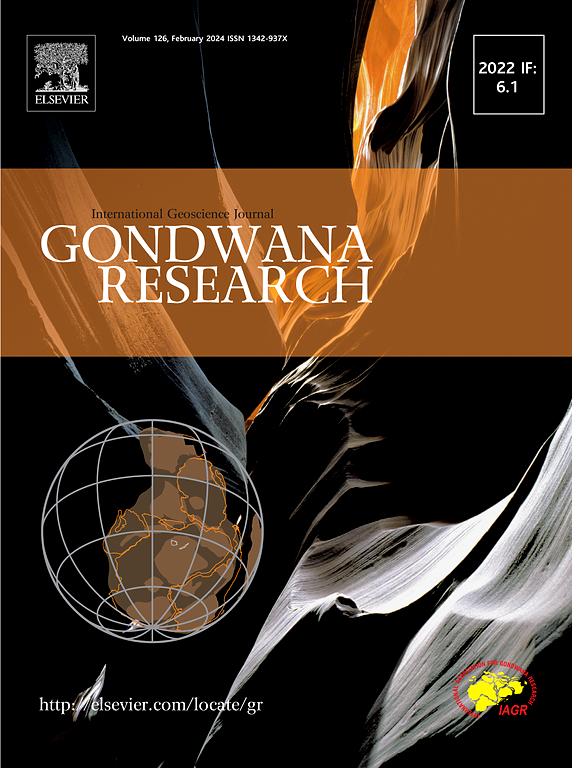Reactionary interaction of upper mantle minerals with SiC at 6 GPa and 1100–1500 °C: Implication for moissanite appearance in ophiolitic peridotite and other uncommon natural environments
IF 7.2
1区 地球科学
Q1 GEOSCIENCES, MULTIDISCIPLINARY
引用次数: 0
Abstract
Experiments were carried out on the interaction of mantle rocks and minerals with SiC at 6 GPa and 1100–1500 °C. Fine powders of natural peridotites and eclogites from kimberlites with the addition of 10 wt% SiC, as well as monomineralic powders and crystals of chromite, olivine, and garnet, were used as starting materials. The experiments were carried out on a 1500-ton multianvil press. In all experiments, the reduction of silicates and chromite was observed with an increase in the magnesium number (Mg#=100 Mg/(Mg + Fe)) of minerals to 97–100 % and the precipitation of metallic phases − alloys in the Fe-Ni and Fe-Si-Cr systems. The most pronounced reactions occurred at 1500 °C. Equilibrium was not reached in all the studied systems even after 72 h of annealing at 1300 °C. Instead, reaction rims were formed on mineral grains and finely dispersed iron alloys were precipitated throughout the volume of crystals. The reaction between SiC and chromite was fastest. The Mg# of chromite changed from 57 (in the initial chromite) to 80–94 %. It was shown that at 6 GPa, SiC reacted quickly with minerals and mantle rocks to form metal phases, high-magnesian silicates, and chromite. This means that they cannot be in equilibrium, as was previously stated for ophiolite peridotite and chromitite, and volcanic rocks such as basalts and kimberlites. The kinetic relationships indicate that a few millimeter grains of SiC can survive in the fluid-free mantle during subduction-exhumation only in cold environments below 700–800 °C. We believe that SiC in most natural rocks is related to anthropogenic contamination. In rare cases, which should be carefully documented, moissanite may have a natural terrestrial origin related to very localized events of formation of highly reduced hydrogen-bearing fluids.

上地幔矿物与SiC在6 GPa和1100-1500℃的反应相互作用:蛇绿橄榄岩和其他罕见自然环境中莫桑石的存在意义
在6 GPa、1100 ~ 1500℃条件下,对地幔岩石和矿物与SiC的相互作用进行了实验研究。以金伯利岩中的天然橄榄岩和榴辉岩的细粉(添加10%的SiC)以及铬铁矿、橄榄石和石榴石的单矿物粉和晶体为起始原料。实验是在1500吨多砧压力机上进行的。在所有的实验中,观察到硅酸盐和铬铁矿的还原,矿物的镁含量(Mg#=100 Mg/(Mg + Fe))增加到97 - 100%,Fe- ni和Fe- si - cr体系中金属相-合金的析出。在1500℃时反应最明显。在1300℃下退火72 h后,仍未达到平衡。相反,在矿物颗粒上形成了反应边缘,并在整个晶体体积中析出了精细分散的铁合金。碳化硅与铬铁矿的反应速度最快。铬铁矿的mg#由初始铬铁矿的57%增加到80 ~ 94%。结果表明,在6 GPa时,碳化硅与矿物和地幔岩石反应迅速,形成金属相、高镁硅酸盐和铬铁矿。这意味着它们不可能像之前所说的蛇绿岩、橄榄岩和铬铁矿,以及玄武岩和金伯利岩等火山岩那样处于平衡状态。动力学关系表明,只有在700 ~ 800℃的低温环境下,几毫米SiC颗粒才能在俯冲-挖掘过程中在无流体的地幔中存活。我们认为大多数天然岩石中的碳化硅与人为污染有关。在应该仔细记录的极少数情况下,莫桑石可能具有与高度还原的含氢流体形成的非常局部的事件有关的自然陆源。
本文章由计算机程序翻译,如有差异,请以英文原文为准。
求助全文
约1分钟内获得全文
求助全文
来源期刊

Gondwana Research
地学-地球科学综合
CiteScore
12.90
自引率
6.60%
发文量
298
审稿时长
65 days
期刊介绍:
Gondwana Research (GR) is an International Journal aimed to promote high quality research publications on all topics related to solid Earth, particularly with reference to the origin and evolution of continents, continental assemblies and their resources. GR is an "all earth science" journal with no restrictions on geological time, terrane or theme and covers a wide spectrum of topics in geosciences such as geology, geomorphology, palaeontology, structure, petrology, geochemistry, stable isotopes, geochronology, economic geology, exploration geology, engineering geology, geophysics, and environmental geology among other themes, and provides an appropriate forum to integrate studies from different disciplines and different terrains. In addition to regular articles and thematic issues, the journal invites high profile state-of-the-art reviews on thrust area topics for its column, ''GR FOCUS''. Focus articles include short biographies and photographs of the authors. Short articles (within ten printed pages) for rapid publication reporting important discoveries or innovative models of global interest will be considered under the category ''GR LETTERS''.
 求助内容:
求助内容: 应助结果提醒方式:
应助结果提醒方式:


